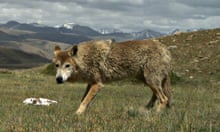A young female gray wolf bid goodbye to her family, left home and crossed the state line into California to find love.
That was in January 2018. For the next two years, the wolf known by scientists OR-54 wandered through mountains and pastures, occasionally killing livestock for food.
Along the way, scientists tracked OR-54’s movements through a radio transmitter collar.
Twice she went home to her parents in Oregon, perhaps complaining of the lack of dates. She even crossed the state line into Nevada last fall. All the while, she kept walking – an average of 13 miles each day – in search of a mate.
Leaving home is a normal thing for a young wolf, says Amaroq Weiss, a biologist at the environmental not-for-profit Center for Biological Diversity. “When wolves get to one and a half or two years old, they are striking out from their birth pack, they are out there looking for mates and territory of their own,” says Weiss.
Even within her family, this was a common thing: OR-54’s father, OR-7, had looked for a mate in California for years before returning to Oregon to have pups. Oregon’s wolves originated from the
OR-54’s story sadly came to a close this week when she was found dead in Shasta county. California’s fish and wildlife department is doing a necropsy to determine the cause of her death; she was only three years old. OR-54’s journey took her further south in California than any other wolf since 1924, when the species was extirpated.
Wolves look for a partner by leaving urine markings and coming back to check them after a little while. “It’s pee-mail,” says Weiss. “But the fact that OR-54 never found a mate and settled down gives us info that there aren’t a lot of wolves in that area.”
Gray wolves, once abundant across the US, were almost completely eradicated by a concentrated effort by the government during the 19th and 20th century. While conservation work is being done to bring them back, their numbers remain low – California has documented about 20 wolves since 2011.
In an area with a healthy gray wolf population, she would have been trying to pair up in December or January and would have been pregnant in February – Valentine’s Day actually has its origins in a celebration of wolf fertility, Weiss says. She should have been giving birth to a litter of pups in April. “She never found a mate in 2018, 2019, and now she’s not going to get to do it,” Weiss says. “Knowing what they’re after while they’re dispersing, you have this sense of an unfilled future.”
Her radio collar linked her with the death of livestock killed in areas she was passing through.
Last fall, the battery on her collar began to die, and the transmissions became more scarce. The data that did come in showed her collar in one spot this winter, not moving. Wildlife officials traced her to the spot, and found her carcass.
The investigation is continuing, so the cause of OR-54’s death is not yet known. Weiss says that the life of a wolf is a rough one – in a pack or solo – and there are many reasons a young, healthy wolf could die. She could have been kicked in the head by a deer while hunting. She could have choked on the liver of a raccoon, which happened to a wolf in Yellowstone. She could have been hit by a car. Or she could have been killed by a poacher.
It wouldn’t be the first time. Another Oregon wolf in California, OR-59, was found dead in suspicious circumstances in December 2018. The wolf was shot near the small communities of Lookout and Bieber, the wildlife agency said. Just last month, officials announced a $2,500 federal award for any information on the wolf’s death.
Gray wolves are covered under both the Federal Endangered Species Act, as well as the California Endangered Species Act, the fish and wildlife department says. “We take very seriously any threats to this recovering wolf population. We are currently investigating the circumstances surrounding OR-54’s death. We remind the public that killing a wolf is a potential crime and subject to serious penalties including imprisonment.”
Weiss says it’s likely that wolves will continue to push south into territory they haven’t experienced since the early part of the 20th century. “We can expect to see more of this in the future as long as there is a good source population in Oregon,” she says.
Weiss adds that this wolf’s death is just another instance that highlights the importance of legal protections for wolves, especially early in their recovery. “Laws may not stop people, but if they are caught, they face real penalties,” she says. “No matter what you think of wolves, poaching is just wrong.”









